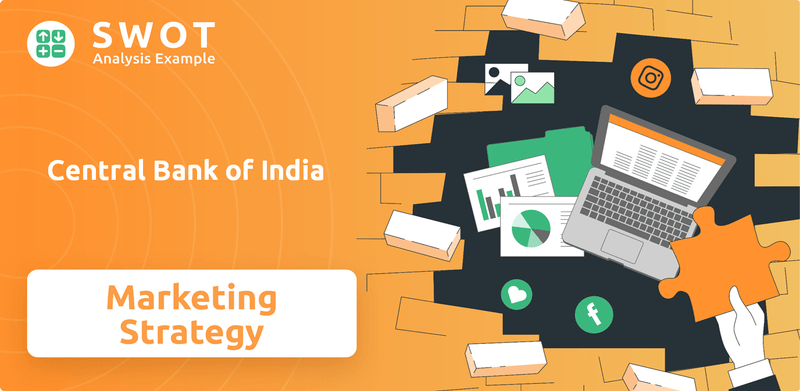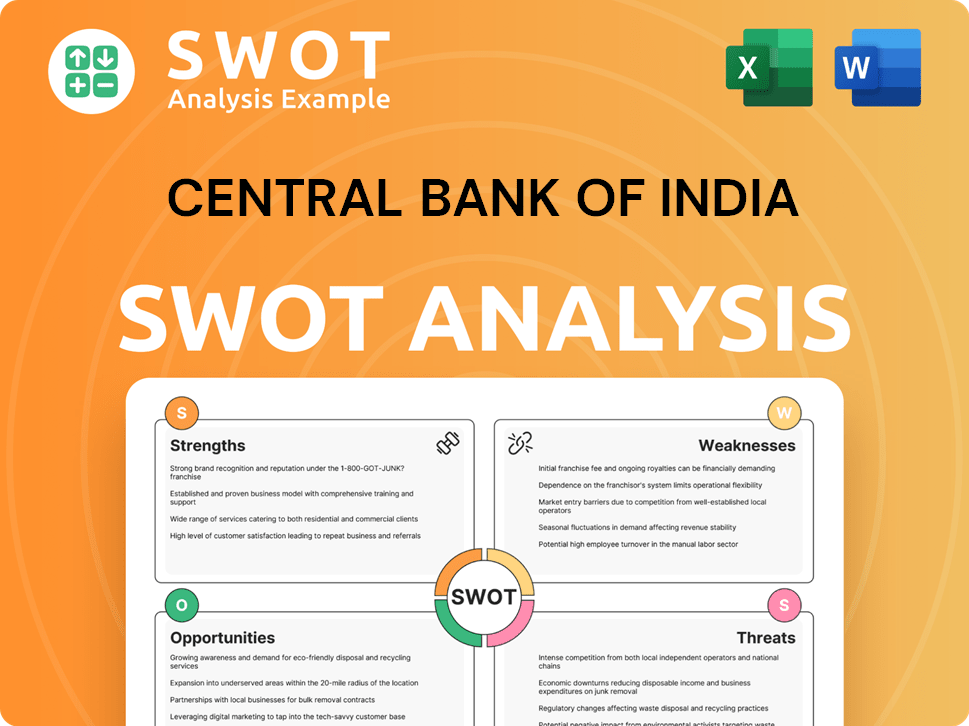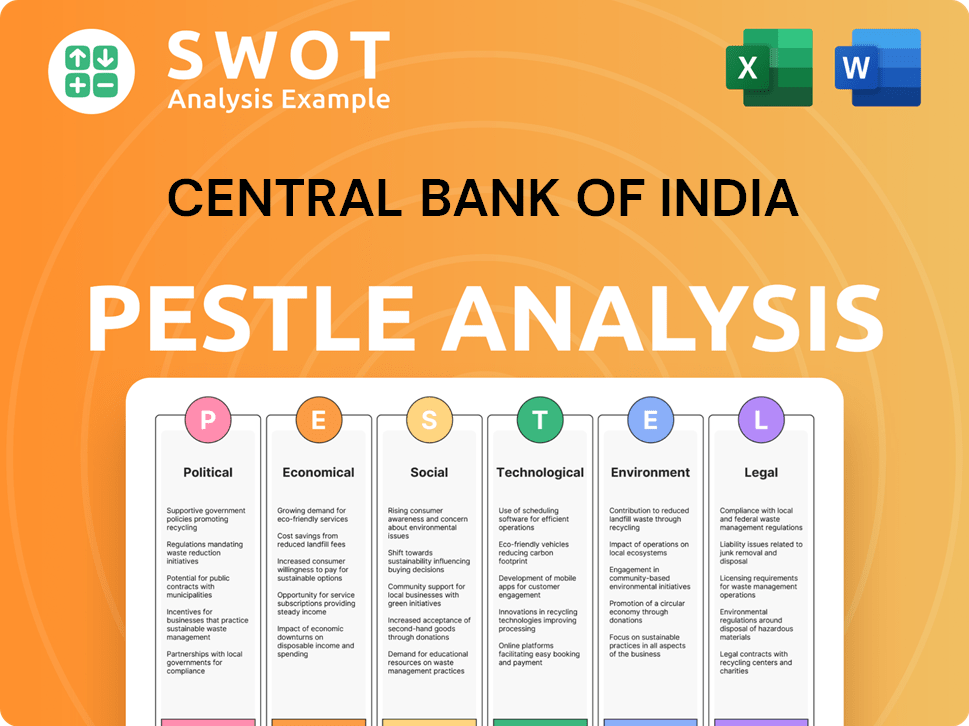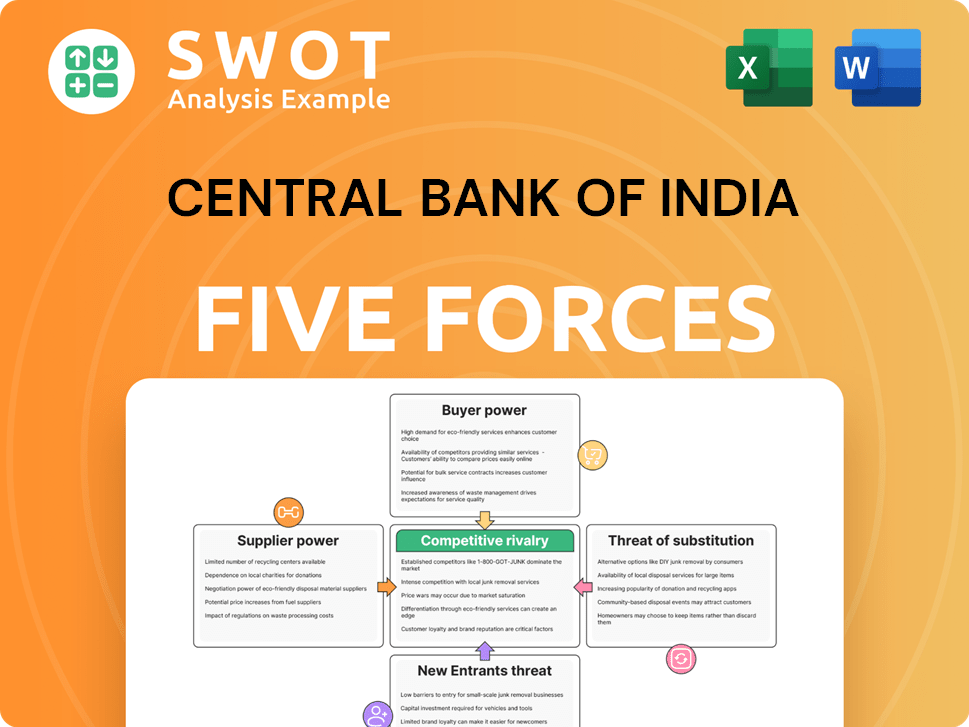Central Bank of India Bundle
How is the Central Bank of India Navigating the Modern Banking Landscape?
Founded in 1911, the Central Bank of India (CBI) has a storied past as a pioneer in Indian banking. Today, it faces the dynamic challenges of a digital-first financial world. This analysis explores the Central Bank of India SWOT Analysis, and the evolving strategies that CBI employs to stay competitive.

Central Bank of India's success hinges on its ability to adapt its sales and marketing strategies. This includes understanding its target audience and leveraging digital channels. The bank's recent initiatives, like the partnership with PSB Alliance Private Limited and NPST, highlight its commitment to innovation and customer-centricity. This document will provide a detailed look at CBI's approach to sales, marketing, and overall business development within the competitive banking sector.
How Does Central Bank of India Reach Its Customers?
The sales and marketing strategy of Central Bank of India (CBI) centers on a hybrid approach, leveraging both physical and digital channels to reach a broad customer base. This strategy, which is a key component of CBI's business development, aims to enhance customer accessibility and engagement. CBI's approach is designed to cater to diverse customer preferences and market dynamics.
CBI's marketing strategy and sales strategy are closely intertwined, focusing on customer acquisition strategies and customer relationship management strategies. The bank's marketing campaigns of Central Bank of India are designed to promote its products and services while building brand awareness. The emphasis is on providing convenient banking solutions through multiple channels.
The bank's sales performance analysis indicates a steady growth trajectory, supported by its strategic initiatives and partnerships. CBI's digital marketing strategy plays a crucial role in expanding its reach and enhancing customer service. The bank's commitment to innovation and customer-centricity is reflected in its sales process of CBI and overall business operations.
Central Bank of India maintains a vast network of physical branches, totaling 3,656 branches and 178 extension counters. These branches are spread across 27 states and 4 union territories, solidifying its presence as an 'All India Bank'. The branches serve as primary touchpoints for traditional banking services, fostering customer trust, especially in rural and semi-urban areas. This extensive network supports CBI's customer acquisition strategies.
CBI has significantly expanded its digital footprint through its website and mobile banking applications. These online channels enable customers to conduct transactions, pay bills, and apply for various services. This shift towards digital adoption reflects the increasing customer preference for online banking services. CBI's digital marketing strategy is key to its growth.
CBI actively engages in strategic partnerships to enhance its market reach and service offerings. In August 2024, CBI partnered with Piramal Finance for co-lending, providing affordable financing solutions to small businesses and retail borrowers. In April 2025, CBI collaborated with NPST to deploy its Qynx platform, expanding offline payment acceptance. These partnerships are critical for CBI's business development.
CBI integrates its physical and digital channels to provide a seamless banking experience. This omnichannel approach ensures that customers can access services and information across various platforms. The integration supports CBI's customer relationship management strategies, enhancing customer satisfaction and loyalty. The Target Market of Central Bank of India is well-served by this strategy.
CBI's sales and marketing efforts are focused on expanding its customer base and enhancing its market share. The bank's initiatives include digital transformation, strategic partnerships, and a customer-centric approach. CBI aims to increase its market share through targeted marketing campaigns and improved customer service.
- Digital Transformation: Enhancing online and mobile banking platforms to provide convenient services.
- Strategic Partnerships: Collaborating with financial institutions to expand reach and offer diverse financial products.
- Customer-Centric Approach: Focusing on customer needs and preferences to improve service quality and customer satisfaction.
- Marketing Campaigns: Launching targeted campaigns to promote new products and services.
Central Bank of India SWOT Analysis
- Complete SWOT Breakdown
- Fully Customizable
- Editable in Excel & Word
- Professional Formatting
- Investor-Ready Format

What Marketing Tactics Does Central Bank of India Use?
The Central Bank of India's (CBI) sales and marketing strategy is a blend of traditional and digital tactics designed to boost brand recognition, generate leads, and boost sales. CBI's approach to digital marketing focuses on content marketing, regularly updating customers on special offers and schemes across various platforms. While specific details on SEO and paid advertising campaigns are not readily available in recent reports, the bank's emphasis on digital transformation suggests an increasing reliance on these tactics to improve its online visibility.
CBI's sales and marketing strategy also emphasizes data-driven marketing, customer segmentation, and personalization. The bank segments its market based on attributes, buying behavior, and socioeconomic background to efficiently reach specific consumer groups. This segmentation allows for more tailored marketing efforts. The choice of target market is influenced by factors such as competition, organizational mission, product life cycle, and financial resources.
The bank's recent financial performance, including a 48.49% year-on-year growth in net profit to ₹3,785 crore for FY2025, with total business crossing ₹7 lakh crore, suggests effective underlying data analysis and strategic execution, indicating the effectiveness of its marketing efforts.
CBI uses content marketing to keep customers informed about special offers. The bank is likely increasing its use of SEO and paid advertising to enhance online visibility.
CBI segments its market based on attributes, buying behavior, and socioeconomic background. This segmentation is crucial for tailored marketing.
The bank segments the market based on factors like buying behavior and socioeconomic background. This helps in creating more focused marketing campaigns.
CBI's robust financial results, including a significant increase in net profit, indicate the effectiveness of its marketing and sales strategies.
Collaborations for digital supply chain finance and offline digital payments highlight innovative approaches to customer experience and market reach.
MoUs with PSB Alliance and NPST demonstrate a strong commitment to digital solutions and partnerships, crucial for competitiveness.
CBI's strategic initiatives include partnerships for digital supply chain finance and offline digital payments, indicating a move towards leveraging technology to enhance customer experience and expand reach. These innovations are key to the bank's marketing plan for new products and customer acquisition strategies.
- Digital Supply Chain Finance: The MoU with PSB Alliance Private Limited in March 2025 for end-to-end paperless financing demonstrates a commitment to digital transformation and risk-optimized lending for businesses.
- Offline Digital Payments: The collaboration with NPST for expanding offline payment acceptance through the Qynx platform in April 2025 highlights an experimental approach to reach customers in various payment environments.
- Customer Relationship Management: CBI likely uses CRM strategies to manage customer interactions and improve satisfaction.
- Brand Building: CBI's marketing efforts contribute to its brand building and help in attracting new customers.
Central Bank of India PESTLE Analysis
- Covers All 6 PESTLE Categories
- No Research Needed – Save Hours of Work
- Built by Experts, Trusted by Consultants
- Instant Download, Ready to Use
- 100% Editable, Fully Customizable

How Is Central Bank of India Positioned in the Market?
Central Bank of India (CBI) strategically positions itself as a trusted financial partner, emphasizing its deep-rooted legacy and extensive presence across India. This positioning is crucial for its Central Bank of India sales strategy and overall brand identity. Established in 1911, the bank's history as the first wholly Indian-owned commercial bank significantly shapes its brand, fostering a sense of national pride and reliability.
The bank's marketing efforts are designed to resonate with a broad audience, from individual customers to businesses and institutions. Its extensive network of 3,656 branches and 178 extension counters across 27 states and 4 union territories underscores its commitment to accessibility. This widespread presence supports its Central Bank of India marketing strategy by ensuring that its services are readily available to a diverse clientele across the country.
CBI's brand messaging focuses on reliability and accessibility, crucial for its target audience. This approach is further reinforced by its involvement in government initiatives, particularly those supporting agro-based and small-scale businesses. This involvement solidifies CBI's image as a bank committed to national development and financial inclusion, which is a key component of its CBI sales and marketing efforts.
CBI leverages its long history and status as a 'people's own bank' to build trust. This legacy is a cornerstone of its brand, helping it stand out in a competitive market. This historical foundation supports its brand's promise of stability and reliability, crucial for attracting and retaining customers.
With a vast network of branches, CBI ensures accessibility for a wide range of customers. This broad reach is a key element of its banking sector marketing strategy, enabling it to serve diverse needs across different regions. This extensive network allows it to cater to a diverse clientele, from individuals to businesses and institutions.
CBI actively participates in government programs, especially those supporting small businesses. This involvement enhances its image as a bank committed to national development. This focus allows CBI to strengthen its relationships with both individual and corporate clients, fostering loyalty and trust.
CBI is adapting to digital trends to improve customer service and engagement. This includes partnerships for digital supply chain finance and offline digital payments. This modernization is essential for maintaining a competitive edge and meeting the evolving needs of its customers.
The financial institution sales approach of CBI is also influenced by the broader trends in the banking sector. The Reserve Bank of India's (RBI) recognition for digital transformation indicates the importance of modernizing service delivery. CBI's efforts in digital transformation, such as digital supply chain finance and offline digital payments, contribute to its modern brand perception. CBI's ability to maintain a strong presence and adapt to shifts in consumer sentiment, particularly by embracing digital banking, is crucial for its continued differentiation in a highly competitive market. For more insights, explore the Competitors Landscape of Central Bank of India.
Central Bank of India Business Model Canvas
- Complete 9-Block Business Model Canvas
- Effortlessly Communicate Your Business Strategy
- Investor-Ready BMC Format
- 100% Editable and Customizable
- Clear and Structured Layout

What Are Central Bank of India’s Most Notable Campaigns?
The Central Bank of India's sales strategy and marketing strategy are multifaceted, focusing on digital transformation, strategic partnerships, and financial performance. These elements collectively drive the bank's growth and brand positioning within the competitive banking sector marketing landscape. The bank's initiatives reflect a commitment to innovation and customer-centric approaches, essential for sustained success.
Key campaigns are not always explicitly named marketing campaigns but rather strategic initiatives that significantly impact CBI sales and marketing efforts. These initiatives contribute to the bank's overall growth by enhancing customer engagement, expanding market reach, and improving financial outcomes. The bank's focus on digital solutions, strategic alliances, and financial performance showcases a robust approach to business development.
The bank has strategically aligned its efforts with the evolving digital landscape and customer needs. This approach is vital for navigating the dynamic financial institution sales environment and achieving long-term objectives.
The Central Bank of India's digital marketing strategy includes significant investments in digital transformation. This aligns with the Reserve Bank of India's push for digital efficiency, setting a precedent for the banking sector. The bank's 'Digital Marketing Manager Course 2024' aims to equip professionals with skills for effective marketing campaigns.
Announced in August 2024, this partnership aims to provide affordable financing to small businesses and retail borrowers. This initiative enhances financial inclusion by offering financial solutions, especially in underserved areas. The collaboration boosts brand visibility and credibility through association with accessible finance and broader economic development.
In April 2025, the bank partnered with NPST to expand offline digital payments using the Qynx platform. This initiative aims to increase customer engagement and drive sales by making digital transactions more accessible. The bank secured a 40% share in enhancing India's offline digital payments infrastructure.
The bank's financial performance reflects the success of its underlying sales and marketing efforts. For the fiscal year ending March 2025, the bank reported a 48.49% year-on-year growth in net profit, reaching ₹3,785 crore. Gross advances grew by 15.24%, reaching ₹2.90 lakh crore, and total business crossed the ₹7 lakh crore mark, with a 10.37% year-on-year increase.
The Central Bank of India's marketing plan for new products and services is centered on customer acquisition and retention. The bank focuses on enhancing its digital infrastructure and expanding its reach through strategic partnerships.
- Enhance Customer Experience: Improve digital services and ease of access.
- Expand Financial Inclusion: Target underserved regions with affordable financing solutions.
- Drive Digital Payments: Increase the adoption of digital transactions through innovative platforms.
- Boost Sales Performance: Improve profitability and market share.
Central Bank of India Porter's Five Forces Analysis
- Covers All 5 Competitive Forces in Detail
- Structured for Consultants, Students, and Founders
- 100% Editable in Microsoft Word & Excel
- Instant Digital Download – Use Immediately
- Compatible with Mac & PC – Fully Unlocked

Related Blogs
- What are Mission Vision & Core Values of Central Bank of India Company?
- What is Competitive Landscape of Central Bank of India Company?
- What is Growth Strategy and Future Prospects of Central Bank of India Company?
- How Does Central Bank of India Company Work?
- What is Brief History of Central Bank of India Company?
- Who Owns Central Bank of India Company?
- What is Customer Demographics and Target Market of Central Bank of India Company?
Disclaimer
All information, articles, and product details provided on this website are for general informational and educational purposes only. We do not claim any ownership over, nor do we intend to infringe upon, any trademarks, copyrights, logos, brand names, or other intellectual property mentioned or depicted on this site. Such intellectual property remains the property of its respective owners, and any references here are made solely for identification or informational purposes, without implying any affiliation, endorsement, or partnership.
We make no representations or warranties, express or implied, regarding the accuracy, completeness, or suitability of any content or products presented. Nothing on this website should be construed as legal, tax, investment, financial, medical, or other professional advice. In addition, no part of this site—including articles or product references—constitutes a solicitation, recommendation, endorsement, advertisement, or offer to buy or sell any securities, franchises, or other financial instruments, particularly in jurisdictions where such activity would be unlawful.
All content is of a general nature and may not address the specific circumstances of any individual or entity. It is not a substitute for professional advice or services. Any actions you take based on the information provided here are strictly at your own risk. You accept full responsibility for any decisions or outcomes arising from your use of this website and agree to release us from any liability in connection with your use of, or reliance upon, the content or products found herein.